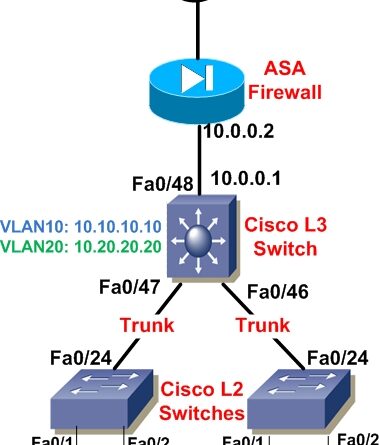Routing Basics: How to Setup Routing Using Cisco Router And Switch-L3
A blog article about routing basics and how it is done using a Cisco router and a switch. There are many different kinds of networks that you might be able to receive internet connection – home, office, guest network in your apartment building, university campus, or even the Internet itself. This routing article will help guide you through choosing the right router and switch for your specific needs!
What is Routing?
Routing is the process of sending packets of data from one network location to another. It is a critical function in the operation of any network. Routers use routing information to send packets to their destinations.
Routing is typically used to send packets between connected networks. For example, you might use routing to send packets from your computer to the Internet. You can also use routing to send packets between different parts of your network. For example, you might use routing to route packets from your office to your home network.
Routers can be used to route packets between two networks that are on the same physical layer (layer 1). They can also route packets between two networks that are on different physical layers.
2. How Do Routers Route Packets?
Paragraphs:
Routers use a variety of algorithms to route packets. The most common algorithm is the default gateway algorithm. This algorithm determines which router should forward a package if it doesn’t have a match in its routing table. The default gateway algorithm is usually configured on routers using the IP default gateway command.
Another standard algorithm is the distance-vector algorithm. This algorithm uses the destination IP address and the distance between
How does direct connectivity work?
One of the great features of routing is that it can connect devices directly without having to go through a gateway or switch. This is called direct connectivity.
Direct connectivity works by creating an internal route between two devices. In order to do this, each device must have a routing table that tells it how to get to the other device. Once the routes are set up, you can use them to send traffic between the devices.
To configure direct connectivity between routers and switches, you first need to create a routing table on each device. On routers, you do this by entering the appropriate commands into the designated Router>configuration area. On switches, you enter the commands into the Switch>configuration area.
Once the routing tables are set up, you need to create internal routes between the devices. To do this, you use the zip command on routers or the interface configuration mode on switches. You specify the source and destination addresses for the route and indicate whether it should be a direct route or a route with a delay (i.e., a route that will wait until traffic needs to travel through it before actually going into effect).
By setting up direct connectivity between routers and switches, you can greatly improve your network
How does a router route data?
When a router receives a packet from one network, it inspects the packet’s header to see which network the packet is destined for. If the packet is destined for a network that the router doesn’t know about, it will look up the route to that network in its routing table. The routing table contains all of the information about how to get packets from one network to another.
Once the router knows how to get the packet to the destination network, it will forward the packet out to the interface on which it was received. If you have more than one interface on your router, you can choose which interface to send the packet out on by using route commands.
Router Adjacencies
Router adjacencies are used to optimize routing performance and minimize routing table size.
Router adjacencies are essential for optimizing routing performance. They allow routers to communicate with each other directly, without going through an intermediate router. This is important because it minimizes the routing table size and reduces the time it takes for packets to reach their destination.
To set up router adjacencies, you first need to configure the routers using the appropriate commands. You then need to create a route on one of the routers that point to the IP address of another router. Finally, you need to enable adjacency mode on both routers. This will make them able to communicate with each other directly.
EIGRP vs OSPF
When it comes to routing, there are two main protocols that most networks use: EIGRP and OSPF. EIGRP is a distance-vector protocol, while OSPF is a link-state protocol.
What this means is that EIGRP relies on information about the distances between routers to calculate the best route, while OSPF depends on information about the state of the network links. This difference can be subtle but can have a big impact on how quickly a router can find a route and how stable the route is.
Both protocols have their own strengths and weaknesses, but overall they’re both very effective in modern networks. It’s important to understand which one your network uses before you start configuring routing protocols so that you make the best choices for your needs.
Convergence Time
When you want to set up routing on a Cisco router or switch, you need to take into account the convergence time. This is the amount of time it takes for the routers and switches to find their own routes and merge their routing tables.
The convergence time is different for each type of network. For example, convergence time for a Cisco router can be as short as 5 seconds, while it can take up to 10 minutes for a switch to converge. You need to factor this in when setting up your routing tables.
You can use the show route command to see how long it has been since the last update to the routing table. The total value in the output will tell you how long ago the route was last updated. If you see a value that is greater than 120 seconds, then there is probably a problem with your network and you should contact your network administrator.
Additional Information
In this article, we will show you how to set up routing on a Cisco router and switch-L. In order to do this, you will need the following:
1. A Cisco router
2. A switch-L module
3. The appropriate routing protocols (OSPFv3, EIGRP, BGP)
4. A computer with the required software installed (Cisco IOS Software)
5. A network diagram understanding




